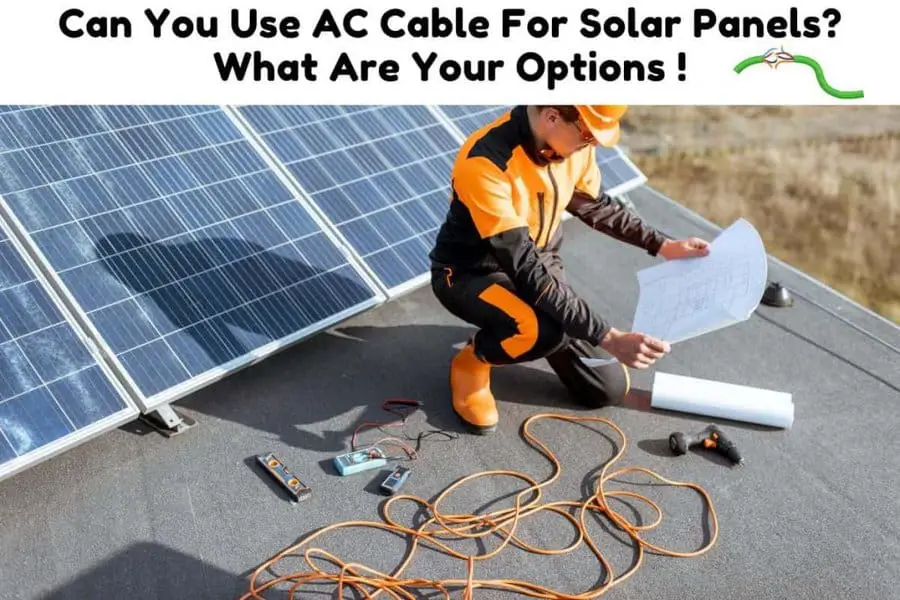AC cables can be used to interconnect solar panels. It is safe and they will move current. While it is possible to wire solar panels using AC cables there are a few reasons why this might not be an ideal configuration.
In this article, we will look at some of those reasons and how they affect a solar system. What is the difference between AC and DC and why does it matter? We will also look into what type of cables are used for solar panels. Are solar cables any different from regular cables?
If you are designing a solar panel system and you’re a little unsure as to which cables you need to use, then the answers in this article will help you.

What Cable Do You Use For Solar Panels?
The main conductor used to interconnect solar panels is PV wire. It is heat, light, and moisture resistant. This makes PV wire ideal for use in the harsh outdoor environment where solar panels operate.
On a side note! If you’re in need of a reliable and high-performance portable solar panel, We strongly recommend the Jackery SolarSaga 100W Portable Solar Panel (Amazon Link).
With a high conversion efficiency and foldable design, this solar panel is easy to transport and set up, making it perfect for outdoor activities like camping, hiking, and RV trips.

The US solar cell technology used in this panel ensures that you get the most efficient and reliable solar charging possible.
There is also a 60W option that is more affordable (Amazon Link)
A solar system can have one or more solar panels connected. When a system has more than one solar panel interconnected, the group of panels is called an array. Cables are used to connect the solar panels in an array. The cables are sometimes called wires or conductors.
There are two types of cables most commonly used for solar arrays. These are PV wire and USE-2 cables. What are PV wire and USE-2 and what is the difference between them?
PV wire
PV wire is sometimes used as an umbrella term for all types of wire used for solar applications. It shouldn’t be, however as this is not entirely accurate. PV wire is a specific type of wire not to be confused with either USE-2 or THNN/THWN wire even though they are all “solar cables”.
PV wire uses stranded copper conductors. The conductors are sheathed in thick insulation to protect them from heat, moisture, and light. PV wire has a temperature rating of 90°C in wet and 150°C in dry conditions.
Also check out if You Can Use THNN Wire For Solar Panels? What Are Your Options!
USE-2
USE-2 is the older alternative to PV wire. USE-2 is more of a general-purpose cable that is also used for solar applications.
Available in both stranded and solid options, USE-2 employs either copper, copper-clad aluminum, or aluminum conductors. Like PV wire it is also insulated to protect against heat, moisture, and light.
PV wire vs USE-2
Which is the better option between the two? PV wire has several advantages over USE-2. It was after all, specifically designed for solar applications.
For one, PV wire has better insulation. This makes it more resistant to heat and light. It is also more flexible and can work with higher voltages compared to USE-2.
On the other hand, USE-2 is much cheaper than PV wire. If you’re working on a tight budget and your system will require long cables you might want to opt for USE-2. In most cases, however, PV wire is a better choice.
Are Solar Cables Different From Regular Cables?
Cables used for solar are different from regular cables. Solar cables are designed to handle outdoor conditions in which they are used much better than regular cables. Solar cables have improved tolerance to heat, moisture, and light.
Solar panels are designed to operate for 25 years. In many cases, they last for up to 40 years. During that time the solar panel, and by extension, the solar cables will experience intense heat, cold, moisture, and UV radiation.
The main factor that makes solar cables more stress resistant than ordinary cables is the sheath or outer insulation. Ordinary cables use copper wire sheathed in Polyvinyl Chloride or PVC. Solar cables use copper wire sheathed in irradiated Cross-linked Polyethylene or XLPE.
The sheath is what makes solar cables more resistant to temperature, humidity, acid, and alkaline. The improved resistance is necessary and gives solar cables a longer lifespan. Solar cables can last up to 25 years whereas ordinary cable has a lifespan of around 8 years. Source
Is There Any Difference Between AC And DC Cable?
AC cables carry alternate current between components in a solar system. This could be from the inverter to connected appliances. DC cables carry direct current generated by solar panels. This could be to either a battery or inverter.
DC cables, because they link solar panels together are always used outside. AC cables provide a link between the inverter and the load as well as the grid if it is a grid-tie system so will, in most cases be indoors.
DC cables typically have two wires, namely a positive and negative wire with the live wire being red and the negative being blue or black. AC cables will have three wires. These are the live and neutral wires as well as a ground wire.
Can AC Wires Be Used For DC?
AC wires can be used instead of DC. A wire is not necessarily AC or DC. Current will still flow as they are both conductors. With that said, however, using AC wire to move direct current is more suited for lower voltage and current applications. The downside to using AC wires in place of DC wires is the reduced efficiency experienced due to the voltage drop in an AC wire.
AC stands for alternate current. The electricity supplied to you by your utility is AC and that is what your appliances run on. DC stands for direct current. The electricity produced by a solar panel or stored in a battery is DC.
The cables that run from solar panels to a battery or inverter in a solar system are DC cables. This is because DC cables have a higher carrying capacity compared to AC cables. There is less energy loss when using DC cables. This is because of the “skin effect”.
The skin effect describes what happens to the current when it moves through a conductor. In a direct current, there is less resistance because the current is distributed evenly across a wire. With AC there is more resistance and hence, power loss. This makes DC a more efficient way to move electricity. Source
The skin effect only becomes a factor at higher frequencies of AC. Much more than what is used for a solar array.
